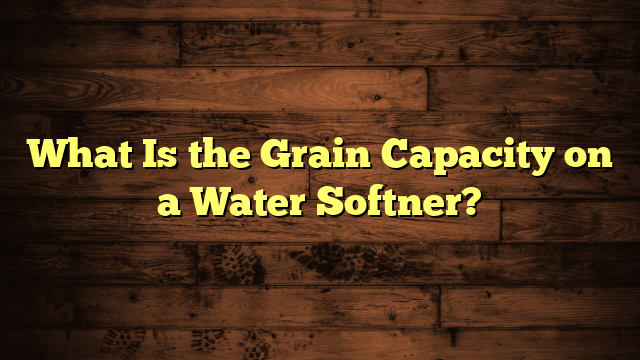What Is the Grain Capacity on a Water Softner?
Like a well-tuned orchestra, a water softener operates best when every component is in sync, particularly its grain capacity. You might wonder what this capacity means for your home and why it's essential to understand it. It plays a significant role in determining how effectively your system can combat hard water issues without unnecessary strain. So, how can you assess the right grain capacity for your needs? Let's explore the factors that come into play and how they can influence your decision.
Key Takeaways
- Grain capacity measures the amount of hardness minerals a water softener can remove before regeneration, typically expressed in grains per gallon (GPG).
- A higher grain capacity indicates greater efficiency, reducing the frequency of regeneration cycles and operational costs.
- Proper grain capacity ensures a consistent supply of soft water, enhancing plumbing and appliance lifespan.
- To calculate grain capacity, multiply household daily water usage by water hardness and regeneration days.
- Regular maintenance and evaluation of grain capacity are essential for optimal water softener performance and water quality.
Understanding Grain Capacity
Understanding grain capacity is essential for selecting the right water softener for your home. Grain capacity refers to the amount of hardness minerals a softener can effectively remove before it needs regeneration. It's typically measured in grains per gallon (GPG) and directly impacts the softener's efficiency.
When analyzing grain measurement, consider the hardness level of your water and your household's water usage. For instance, if your water has a hardness of 10 GPG and your family uses about 80 gallons per day, your softener will need a capacity of at least 800 grains to handle daily demands.
A higher grain capacity indicates that the softener can treat larger volumes of water before regeneration, enhancing its overall efficiency. This means fewer regeneration cycles, which not only saves salt and water but also prolongs the lifespan of your softener.
Ultimately, understanding grain capacity helps you choose a unit that matches your specific needs, ensuring peak performance and cost-effectiveness. By evaluating both water hardness and daily consumption, you can determine the correct grain capacity for your water softener, leading to better water quality in your home.
Importance of Grain Capacity
While selecting a water softener, the significance of grain capacity can't be overstated. Grain capacity directly influences how effectively your system can handle hard water, impacting both performance and longevity. A water softener with an appropriate grain capacity guarantees that you won't frequently run out of soft water, which can disrupt your daily activities.
Opting for a water softener with the right grain capacity enhances cost efficiency. If your system is too small, you'll face higher salt and maintenance costs due to frequent regenerations. Conversely, an over-sized unit might lead to unnecessary expenses and wasted resources. By accurately evaluating your grain capacity needs, you can achieve a balance that minimizes operational costs while maximizing performance.
Moreover, the long-term benefits of selecting the right grain capacity are significant. Properly sized softeners reduce wear and tear on plumbing and appliances, ultimately extending their lifespan. This not only saves you money on repairs and replacements but also improves the overall quality of your water.
To summarize, understanding and prioritizing grain capacity is essential for an effective, economical, and sustainable water softening solution.
How to Calculate Your Needs
To choose the right water softener, you need to calculate your grain capacity requirements based on your household's water usage and the hardness of your water supply.
Start by evaluating your water quality to determine the hardness level, usually measured in grains per gallon (gpg). Next, analyze your household's usage patterns to estimate daily water consumption.
Here's how to calculate your needs:
- Determine your household size: More people typically mean higher water usage.
- Estimate daily water usage: The average person uses about 80-100 gallons per day.
- Measure water hardness: Use a water testing kit to find out the gpg in your water supply.
- Calculate total grain capacity: Multiply your daily water usage by the hardness level, then multiply by the number of days you want the softener to last between regenerations.
For example, if your household consists of four people, uses 300 gallons daily, and your water hardness is 10 gpg, you'll need a softener with a grain capacity of at least 12,000 grains.
Factors Affecting Grain Capacity
When determining your water softener's grain capacity, several key factors come into play.
You'll need to assess the hardness level of your water, the size of your household, and how often the system regenerates.
Each of these elements directly influences the overall effectiveness and efficiency of your water softening system.
Water Hardness Level
The hardness level of water considerably influences the grain capacity of a water softener. When evaluating your water quality, it's important to understand how hard water affects the performance of your system. Hardness is primarily measured by the concentration of calcium and magnesium ions. You can determine your water hardness using various testing methods, such as test strips or water sample analysis.
Here are some key factors to think about regarding water hardness:
- Calcium concentration: Higher levels lead to increased grain capacity needs.
- Magnesium presence: Like calcium, magnesium contributes to the overall hardness.
- Total hardness measurement: It's vital to know the combined levels of calcium and magnesium.
- Water usage patterns: This can affect how often regeneration cycles are needed.
Understanding these factors will help you select a water softener with the appropriate grain capacity, ensuring efficient ion exchange and effective softening.
Household Size Impact
Understanding how household size impacts grain capacity is essential for optimizing your water softener's efficiency. The amount of water you and your family use directly correlates with the grain capacity required for effective water softening.
Larger households typically consume more water due to increased usage in activities like laundry, dishwashing, and bathing. This elevated demand necessitates a higher grain capacity to guarantee that the water softener can adequately handle the volume and hardness of the water being processed.
Your household habits also play a significant role. If your family lifestyle includes frequent showers, dishwashing, or laundry, the softener will deplete its grain capacity faster. Conversely, if you have a smaller household or less intensive water usage, a lower grain capacity may suffice.
Understanding your family's specific needs will help you select the right grain capacity. Evaluating your daily water consumption, along with considering your household habits, aids in choosing a water softener that meets your demands, guaranteeing consistent water quality and efficiency.
Ultimately, aligning grain capacity with household size and lifestyle is key to maximizing the effectiveness of your water softening system.
Regeneration Frequency Considerations
Regularly considering regeneration frequency is crucial for optimizing your water softener's grain capacity.
The frequency of regeneration cycles considerably affects how well your system performs and how efficiently it uses its capacity. Here are some factors to keep in mind:
- Water hardness: The harder your water, the more frequently your softener will need to regenerate.
- Household usage: More occupants mean higher water consumption, resulting in increased demand for regeneration cycles.
- Salt dosage: Using the right amount of salt during regeneration can enhance capacity optimization and overall efficiency.
- Softener size: A properly sized unit for your household needs ensures optimum performance, reducing unnecessary regeneration.
Types of Water Softeners
When choosing a water softener, you'll encounter several types, including ion exchange softeners and salt-free systems.
Ion exchange units effectively remove hardness minerals using a resin, while salt-free systems employ alternative methods to prevent scale buildup.
Understanding these options will help you determine the best fit for your water treatment needs.
Ion Exchange Softeners
Ion exchange softeners are among the most widely used types of water softeners, efficiently removing hardness minerals like calcium and magnesium from water.
They work by utilizing ion exchange materials, typically in the form of resin types, to swap these hardness ions for sodium or potassium ions. This process not only softens the water but also improves its quality for everyday use.
When considering an ion exchange softener, you'll find several key features:
- Resin types: Different resins have varying capacities for ion exchange, affecting efficiency.
- Regeneration cycles: Regular regeneration is necessary to maintain performance, typically using salt.
- Grain capacity: This indicates the total hardness minerals the softener can handle before regeneration is required.
- Water flow rate: Verify the system can meet your household's water demands without compromising softening efficiency.
Salt-Free Systems
While ion exchange softeners effectively tackle hard water issues, salt-free systems offer an alternative approach to managing water hardness. These systems use technologies like template-assisted crystallization or magnetic fields to prevent scale buildup without actually removing minerals from the water.
Here's a quick comparison of salt-free systems:
| Feature | Salt-Free Benefits | Salt-Free Alternatives |
|---|---|---|
| Maintenance | Lower maintenance requirements | Minimal upkeep needed |
| Health Impact | No sodium added to water | Suitable for low-sodium diets |
| Environmental Impact | Eco-friendly and sustainable | Reduces water waste |
Salt-free systems aren't technically softeners since they don't remove hardness minerals. Instead, they condition water, making it less likely to form scale in pipes and appliances. If you're looking for a more environmentally friendly option, these systems may be the right choice for you. However, keep in mind that they might not completely eliminate hard water symptoms. Understanding your needs is essential when exploring salt-free alternatives to guarantee you choose the best system for your household.
Signs of Insufficient Capacity
A water softener's performance can diminish considerably if its grain capacity is insufficient for your household's needs. Recognizing the warning signs of insufficient capacity is vital for maintaining water quality and appliance efficiency.
Here are some indicators to watch for:
- Hard water stains on faucets and showerheads, indicating mineral buildup
- Dry skin and hair after bathing, suggesting ineffective softening
- Soap scum in sinks and tubs, a telltale sign of unsoftened water
- Increased laundry wear, where clothes feel rough or appear faded
If you notice any of these signs, your water softener may not be regenerating effectively or could be undersized for your water usage.
This insufficient capacity can lead to long-term issues, not just for your plumbing and appliances, but also for your health and comfort.
Regularly monitoring these indicators can help you determine if it's time to adjust your system or consider upgrading to a unit that better meets your household's demands.
Addressing these concerns promptly guarantees you're getting the most out of your water softener and protecting your home from hard water damage.
Maintenance and Regeneration
Regular maintenance and regeneration are vital for guaranteeing your water softener operates efficiently and effectively. To keep your system running smoothly, follow these maintenance tips:
| Task | Frequency | Notes |
|---|---|---|
| Check salt levels | Monthly | Keep salt tank at least half full. |
| Clean brine tank | Every 6 months | Prevent salt bridges or clogs. |
| Inspect resin beads | Annually | Replace if they appear damaged or discolored. |
| Test water hardness | Quarterly | Verify proper softening levels. |
The regeneration process is essential for replenishing the resin beads that capture hardness minerals. Typically, this should occur based on water usage or hardness levels. You can set it to occur automatically, or you may need to initiate it manually depending on your system. During this process, brine is introduced to the resin, flushing out the accumulated hardness ions. Regularly monitoring your system and performing these maintenance tasks will enhance performance, extend the lifespan of your water softener, and guarantee you consistently enjoy softened water. Implement these practices, and you'll maintain peak function efficiently.
Choosing the Right Capacity
After guaranteeing your water softener is well-maintained and regenerating properly, the next step is selecting the right grain capacity for your household's needs.
Proper softener sizing is vital for efficiency and effectiveness. To determine the ideal capacity, consider these factors:
- Household Size: How many people live in your home?
- Water Hardness: What's the hardness level of your water supply?
- Daily Water Consumption: How much water do you use daily?
- Usage Patterns: Are there peak times when water usage spikes?
By conducting a capacity comparison based on these elements, you can guarantee you're choosing a system that meets your demands without unnecessary waste.
A softener that's too small may struggle to keep up, while one that's too large can lead to increased salt usage and costs.
For example, a household of four with hard water may require a 30,000-grain softener. Meanwhile, a smaller household might find a 24,000-grain model sufficient.
Ultimately, understanding your specific needs will lead to a more efficient and cost-effective water softening solution.
Frequently Asked Questions
Can Grain Capacity Affect Water Heater Efficiency?
Yes, grain capacity affects your water heater's energy efficiency. A properly sized water softener prevents scale buildup, improving heat transfer and reducing energy consumption. Ensuring ideal grain capacity can lead to significant savings on utility bills.
What Happens if I Exceed My Softener's Grain Capacity?
If you exceed your softener's grain capacity, you'll face capacity issues, leading to inefficient softening and potential damage. Regular softener maintenance becomes essential to prevent these problems and guarantee peak performance and longevity of the system.
How Often Should I Check My Softener's Grain Capacity?
You should check your softener's grain capacity regularly, ideally monthly, to guarantee peak performance. Keep an eye on capacity indicators and prioritize softener maintenance to prevent issues that could affect water quality and efficiency.
Do Different Water Sources Require Different Grain Capacities?
Yes, different water sources have varying water hardness levels, which affects softener selection. You'll need to choose a softener with an appropriate grain capacity to effectively manage the hardness in your specific water supply for ideal performance.
Can I Upgrade My Water Softener's Grain Capacity?
Yes, you can upgrade your water softener's grain capacity. Water softener upgrades enhance efficiency, ensuring better water quality and longer intervals between regenerations, ultimately providing significant grain capacity benefits for your household's needs.
Conclusion
In summary, understanding grain capacity is essential for ensuring your water softener meets your household's needs. With the right capacity, you'll enjoy consistent soft water without frequent maintenance. Have you considered how your daily water usage and hardness levels impact your choice? By evaluating these factors, you can select a water softener that maximizes efficiency and minimizes costs, providing you with peak performance for years to come. Make sure you're not left with hard water when you need soft!







